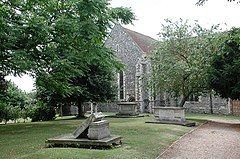Minster-in-Thanet
| Minster-in-Thanet | |
|---|---|
 Church of St Mary the Virgin, Minster-in-Thanet |
|
| Minster-in-Thanet shown within Kent | |
| Population | 3,569 (2011) |
| OS grid reference | TR308645 |
| Civil parish |
|
| District | |
| Shire county | |
| Region | |
| Country | England |
| Sovereign state | United Kingdom |
| Post town | RAMSGATE |
| Postcode district | CT12 |
| Dialling code | 01843 |
| Police | Kent |
| Fire | Kent |
| Ambulance | South East Coast |
| EU Parliament | South East England |
| UK Parliament | |
Minster-in-Thanet, also known as Minster, is a village and civil parish in the Thanet District of Kent, England. The village is situated to the west of Ramsgate and to the north east of Canterbury; it lies just south west of Kent International Airport and just north of the River Stour. Minster is also the "ancient capital of Thanet". At the 2011 Census the hamlet of Ebbsfleet was included.
The name comes from the Latin monasterium and denotes the historical presence of an abbey or monastery.
Archaeology has shown a Bronze Age settlement at Minster-in-Thanet. The area became part of the Roman Empire under the emperor Claudius which four centuries later was ceded to the Saxons around 450AD.
In 597 Augustine of Canterbury is said, by the Venerable Bede, to have landed with 40 men at nearby Ebbsfleet, in the parish of Minster-in-Thanet, before founding a monastery in Canterbury; a cross marks the spot of his landing.
Minster itself originally started as a monastic settlement in 670 AD. The buildings are still used as nunneries today. The first abbey in the village was founded by St. Domneva, a widowed noblewoman, whose daughter St. Mildred, is taken as the first abbess. The tradition is that Domneva was granted as much land as a hind could run over in a day, the hind remains the village emblem, see also Thanet. The abbey was extinguished by Viking raiding. The next abbess after St. Mildred was St Edburga daughter of King Centwine of the West Saxons.
The third known abbess was Sigeburh, who was active around 762 AD and is known from the Secgan hagiography and from Royal charters. In 761AD Offa, king of the Mercians, granted Sigeburh a toll-exemption which king Æthelbald had previously granted to Abbess Mildrith. Again in about 763 AD Eadberht II, king of Kent, granted the remission of toll on two ships at Sarre and on a third at Fordwich. It has been stated that in gaining these privileges, she may have been taking advantage of Æthelbald's political weakness.
Vikings attacked the surrounding area in 850 AD.
...
Wikipedia

